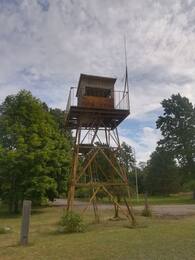Slītere State Reserve in the border regime zone
Memories of former employees of the Slītere State Reserve about the Soviet era.
Vilnis Skuja: During the Soviet era, I worked in the Slītere State Reserve. We had to meet with border guards often, but we tried to avoid such meetings, because in the border zone, the reserve employees - men with binoculars in their hands, a map in their bag and a camera - ordered every border guard to stop at once and clarify the circumstances of the case. Then there was an explanation, which usually lasted no less than half an hour. If we managed to notice the border guard car in time, we quickly ran into the forest. We even had such a cry "green people are going"! At that moment, everyone automatically hid somewhere. If there was a need (for example, to observe bird migration, take censuses, etc.) to go to the beach, we always officially reported to the so-called zastava. Then there were no problems, because there were also reasonable people in the border guard who did not resort to any repression or bad attitude towards us and other locals. The exception was in cases where a person (local or immigrant) was sharp and asked for trouble.
Border guards also committed various illegalities. They cut down a tree, dug sand or a trench in the wrong place. Once they were caught in the Kolka dump, where they had illegally shot a wild boar. There were cases when workers hired by the army managed to get a Kalashnikov to go on illegal hunting. Although fishing between Kolka and Ventspils was officially prohibited, under the cover of border guards, local residents could not quite legally go to sea and fish. For such actions, they “paid bribes” to the border guards. And this was the only way fishing could take place.
Border guard posts were in Kolka and Mazirbe. At one time, posts were also built in Saunaga and Pitrag as props or models. Searchlights that illuminated the sea and the coast at night were located near Kolka and Mazirbe. It was allowed to be on the Mazirbe beach (in summer) from 08:00 to 22:00 and a sign warned about this in two languages. Mazirbe was one of the largest beaches. In the other Liv villages, there were only small sections of the coast where civilians were allowed to stay. In the eighties, there was even an idea to build a continuous barbed wire fence along the entire length of the coast. For this purpose, pulpwood had already been purchased from the Slītere reserve.
Alanda Pūļiņa: When I was still working in the Slītere State Reserve during the Soviet era – the administration of the reserve was located in the Livonian Folk House. I remember the border guard raids, that there was increased control – the border guards with bobiks made raids and even asked the same people to show their documents several times. From those times I still had a pass (a pass to the border regime zone). If you were driving to Mazirbe from Dundaga, the border regime zone began already in Jaundundag, where there was a barrier and a border guard post.
Related objects
Mazirbe Nautical School
The Soviet Border Guard Tower in this complex is one of the best preserved of its kind on the Latvian coast. Unfortunately, the condition of the buildings is poor, there is a rifle loading/unloading site on the site, and a drive and fragments of trenches have been salvaged.
The Coast Guard post was located in the former Marine School building. In the post-Soviet period, accommodation was offered in parts of the buildings.
The second tower of the Soviet Border Guard is located about 400 m from the beach, but unfortunately it is in a state of disrepair. However, the Mazirbe boat cemetery is located not more than 500 m from the beach tower towards Sīkrags.





